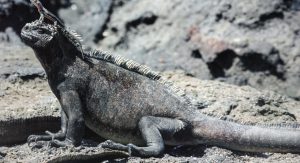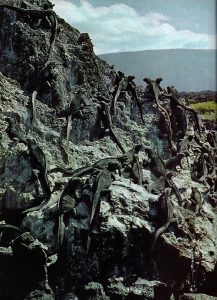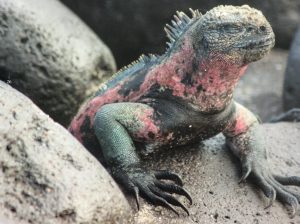This is the last article in my six-part series on the Galápagos Islands. While Charles Darwin did an exemplary job of describing the findings of his five-week exploration of the islands in his 1845 book (Voyage of the Beagle), his evolutionary theory that resulted and that he called Natural Selection has proved to be a complete dud.
In an earlier article in this series, I covered the Giant Tortoises of Galápagos and in this article I will look at some of the other reptiles found there. A reptile is defined as “any of a class (Reptilia) of air-breathing vertebrates that include alligators and crocodiles, lizards, snakes, turtles, and extinct related forms and are characterized by a completely ossified skeleton with a single occipital condyle, a distinct quadrate bone usually immovably articulated with the skull, ribs attached to the sternum, and a body usually covered with scales or bony plates.” Lizards are defined as “reptiles in the order Squamata that have four legs and a long tail, eardrums, and movable eyelids.”
Besides the giant tortoises other endemic reptiles found in the archipelago are the Marine Iguana, the Land Iguana, the Lava Lizard, Leaf-toed Geckos, and several species of snakes. However, in this article I will be focusing just on the iguana lizards since I think they are the most unique.
Marine Iguana:
The endemic Galápagos Marine Iguana (Amblyrynchus cristatus) is the only sea-going lizard known. Charles Darwin described this animal as “a hideous-looking creature, of a dirty black color, stupid, and sluggish in its movements.” Later he called them, “hideous reptiles.” So, it could be said he was not too impressed by their looks.
 Galápagos Marine Iguana with Lava Lizard on its Head (Purdom)
Galápagos Marine Iguana with Lava Lizard on its Head (Purdom)
The marine iguanas have long tails that are flattened vertically, and they use it to move through the water as they undulate it and their bodies side to side. The legs are not used at all for swimming, as they are held tightly to their sides when in the water. This lizard has long, clawed feet that are well suited for climbing onto and clinging to the lava rocks in their Galápagos habitat.
 Typical Marine Iguana Grouping on the Galápagos Lava Rocks (Moore)
Typical Marine Iguana Grouping on the Galápagos Lava Rocks (Moore)
Being cold-blooded they need to spend much of their time basking in the sun after a period of searching for food in the cold ocean water. They are herbivorous and forage mainly on the red and green algae (seaweed) that grows rapidly on the rocks in the water. Darwin reported that they can stay alive if held under water for an hour, but a normal time for underwater foraging is only 5 to 10 minutes.
Salt glands located above the eyes and connected to the lizard’s nostrils by a duct are designed to collect excess sea salt and when the lizards sneeze the salt out of their nostrils their faces can become encrusted with the salt. The males are larger than the females and are also more distinctly colored, especially during mating season. An average male is three to four feet long and can weigh up to thirty pounds. Females lay about four leathery eggs in sandy areas and then protect the nest until the little ones hatch. The hatchlings are then on their own and many lose their young lives to the snakes, gulls, and other predators that share the island with them. For the older iguanas the only significant natural predator is the Galápagos hawk.
 Marine Iguana Clawed Feet (Purdom)
Marine Iguana Clawed Feet (Purdom)
Land Iguaua:
There are two species of the land iguana endemic to the Galápagos. They are Conolophus subcristatus and the Santa Fé species Conolophus pallidus. C. subcristatus is relatively widespread throughout the islands while C. pallidus is confined to the island of Santa Fé. There are several thousand individual land iguanas that inhabit the archipelago, but there has been a serious decline in population since 1835 when Darwin complained there was little room for his expedition to pitch their tents due to the many burrows of the land iguanas. Adult land iguanas grow to be about the same size as do the marine iguanas.
 Galápagos Land Iguana (Purdom)
Galápagos Land Iguana (Purdom)
Creation scientist T.C. Wood statistically analyzed all the Galápagos’ groups of iguanas and published his findings that they all stem from the original pair that survived on board the ark. The marine and land iguanas eat different foods and look quite different, but they still can produce hybrids (see below). The land iguanas generally are a pale to dark yellow color. The land iguanas excavate burrows for egg laying and this practice limits their habitat to the areas of the islands where it is possible for the burrows to be dug. Adult land iguanas mainly eat the pods and fruit from the Opuntia cactus. They will also eat insects and other arthropods which is the diet of the younger iguanas.
Hybrid Galápagos Iguana:
Marine and Land Iguanas do mate and hybridize on occasion. This is a good indicator that both the marine and land are of the same created kind. The hybrid is mainly dark skinned with regular bands of pale markings. The head resembles the marine more than the land and it feeds on cactus pads not seaweed. It is thought that the hybrid is sterile but that is not definitive.
J.D. Mitchell
Related Articles:




